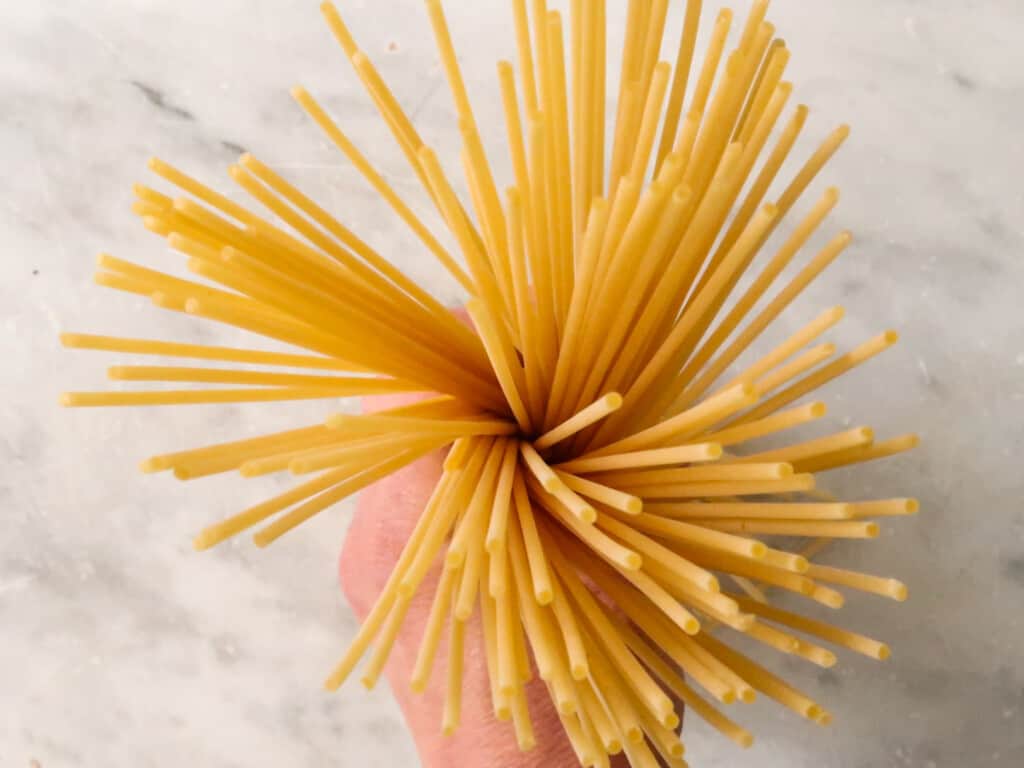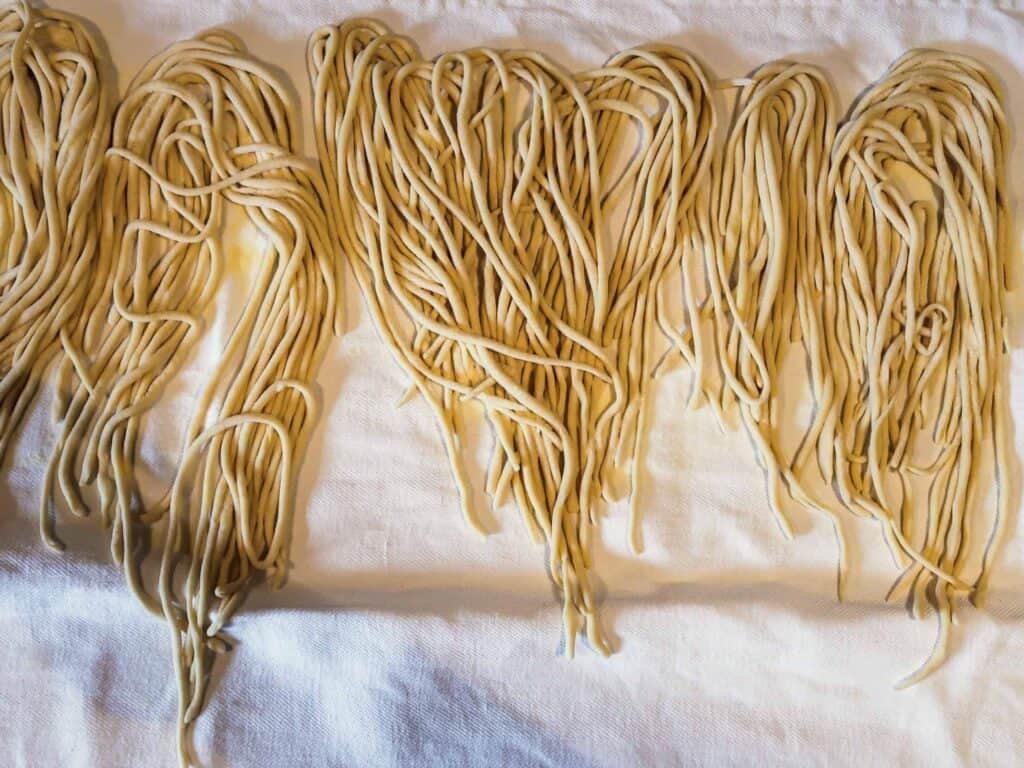Last updated on April 19th, 2024
If you live outside of Italy then you know the hefty price paid for a wedge of parmigiano-reggiano. So why would you ever throw a single crumb of parmesan away? You wouldn’t, of course!
Leftover parmesan rinds are pure gold and are one of the best ways to add additional flavor and richness to numerous dishes.
Here in Italy, you would never see someone throwing away the precious leftover parmesan rind. Apart from the fact that it’s basically throwing money out the window, parmesan rinds are also packed with amazing flavor that can be recycled in many traditional Italian dishes and methods of cooking.
In this article, I will walk you through the best and simplest ways to add a burst of flavor to several dishes with leftover parmesan rinds. I will go over the basics of parmesan in Italy, how to store the rinds and what are the best techniques and dishes to use leftover parmesan rinds just like we do here in Italy.
Note: In this article, I am referring to real parmesan cheese from Italy, also known as parmigiano-reggiano, not imitation parmesan cheese made outside of Italy’s borders.
Jump to Section
What Are Parmesan Rinds?

A parmesan rind is the outermost layer that is formed during the cheese making process of parmesan (12-40+ months). When parmesan cheese is left to age, a hard shell is formed as the outside air dries this out. Real parmigiano-reggiano rinds have no additives or wax unlike other cheese rinds that might be made with the addition of wax.
The outside of a parmesan wheel is completely hard, smooth and firm. If you touch it with your fingers, it’s slightly greasy as well.
The thickness and richness of the rind will depend on how long it’s been aged. Younger parmesan rinds will be thinner, less hard and less complex while the older or more aged parmesan rinds will be thicker, harder and extremely flavorful.
Fact: Parmesan that is not produced in Emilia-Romagna under the specific certification of parmesan making, it’s known as parmesan while all the authentic DOP parmesan made in Emilia-Romagna is called parmigiano-reggiano.
Are Leftover Parmesan Rinds Edible?
When we are talking about real parmigiano-reggiano, we know that there are no additives or wax in the parmesan rind, making it 100% edible. They are just simply the naturally formed crust of the parmesan cheese during the aging process.
This being said, the outside parmesan rind is very hard and not very nice to eat. It is packed with flavor but it needs to be softened with heat before it becomes editable.
Parmigiano-Reggiano Vs. Parmesan

Parmigiano-reggiano is a DOP cheese (a classification of food production characterized by specific techniques of production and geographical location) that must be made in the region of Emilia-Romagna in Italy and matured for a minimum of 12 months (and upward of 40 months!).
Fact: You can tell real parmigiano-reggiano from parmesan cheese by the rind. If you see the letters ‘parmigiano-reggiano’ stamped on the outside of the rind, it’s authentic parmigiano-reggiano from Italy. If not, it’s an imitation parmesan.
Every wheel of parmigiano-reggiano goes through a strict and rigorous series of quality tests, making it one of the most curated and prized cheeses in the word. And this, my friends, is the reason for its hefty price tag!
Outside of Italian borders, the word ‘parmesan’ refers to any kind of hard, cow’s milk cheese that is made in a similar way but not in Emilia-Romagna in accordance with the strict DOP Italian laws that delineate its production. In other words, parmesan cheese is used to describe any imitation parmigiano-reggiano cheese.
Parmesan is not nearly as flavorful and complex as the real deal. The rind of real parmigiano-reggiano is also much thicker and richer than imitation parmesan cheese rinds.
Why Add Leftover Parmesan Rinds?

The short answer, FLAVOR! Parmesan rinds are essentially concentrated flavor of the actual cheese itself and thus, can add a ton of complexity, richness and body to any dish.
Don’t forget that much of Italian cooking is based on la cucina povera, or the poor man’s cooking which involves using simple, local ingredients to create delicious, hearty meals. Within this concept of cooking lies the premise that nothing is thrown away, including a parmesan rind.
In addition, the leftover parmesan rind also adds a certain silky consistency to whatever you are making, be it a stew, sauce or broth.
The reason parmesan is unique and unlike other flavor profiles is because it adds not only a nutty, salty bite but also contains an aspect of fat and acid.
Fact: Amazing food is a balance between salt, fat, acid and heat. Parmigiano-reggiano embodies three of these aspects all-in-one!
Tips For Cooking With Leftover Parmesan Rinds
Use these general tips and rules for cooking with leftover parmesan rinds in any recipe you want, including these techniques and recipes listed below.
- Add the rind at the beginning of cooking and keep in the pot for at least 30 minutes to maximize the flavor release.
- No matter what you are making, stir the pot every so often to ensure the rind doesn’t stick to the bottom of the pot.
- Before serving, fish out the leftover parmesan rind. Although you can eat them, the point is to add flavor and richness to the dish, which you have just done so you can feel at peace throwing it out at this point.
Good To Know: Check with your deli counter or specialty cheese shop to see if they sell parmesan rinds at a discounted price. Here in Italy you can go to any cheese store and pick them up for a fraction of the per pound price of parmesan cheese!
Leftover Parmesan Rinds In Sauces
Leftover Parmesan Rinds In Tomato Sauce

Tomato sauce and parmesan cheese is a match made in heaven, especially when we are talking about pasta.
Simply add the leftover parmesan rind to the soffritto and let time do its magic. The longer it slowly simmers, the better.
Leftover Parmesan Rinds In Bolognese Sauce
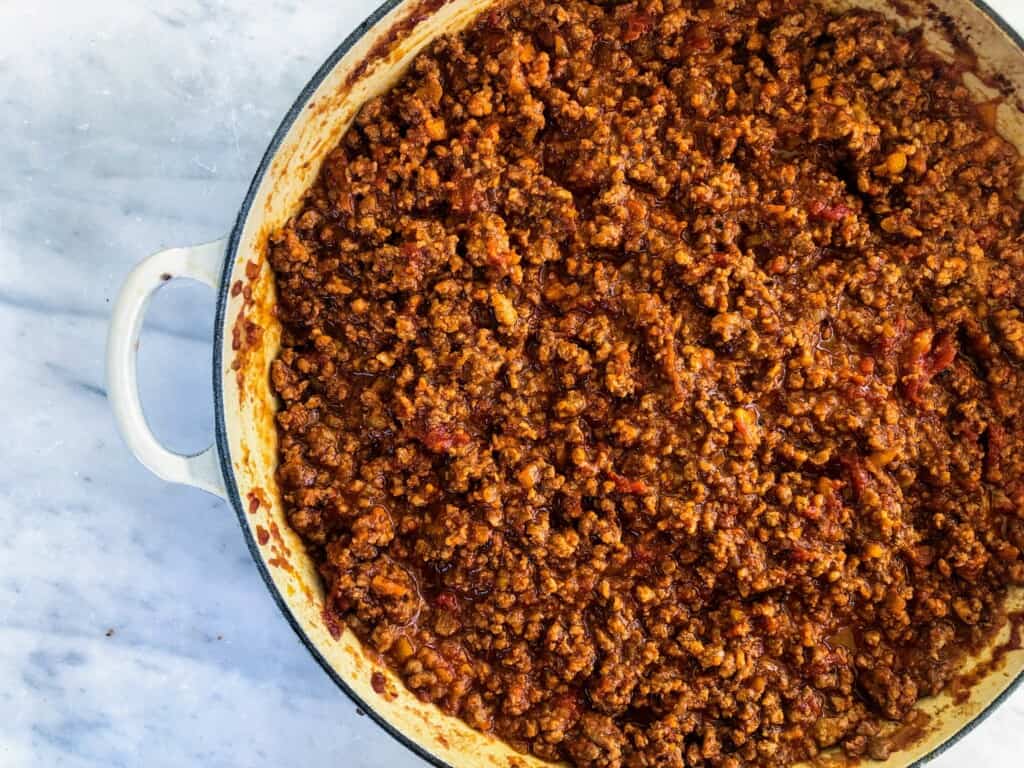
Although here in Italy we would consider bolognese sauce to be already luxurious enough on its own, it can be even further amped up with the addition of a leftover parmesan rind.
When adding a leftover parmesan rind to something like a meat sauce, the parmesan rind flavor is never going to overpower the robust meat but it does add an element of silkyness that simply cannot be replicated. The parmesan rind helps to bind everything together, making your meat sauce even more luxurious.
In this case, add the parmesan with the wine and tomatoes instead of with the soffritto. This is because it can burn when you brown the meat.
Leftover Parmesan Rinds In Bechamel
Bechamel is a white sauce made from a roux of cooked flour and butter that is then thickened with milk to form the base for many baked Italian pasta dishes. In English, it’s sometimes referred to as cheese sauce because it’s the perfect base to melt cheese into.
When adding a leftover parmesan rind into a bechamel sauce, add it when you are making the roux, that is, melting the butter and cooking the flour with it over low heat. The nutty aspect of the parmesan really shines in a bechamel.
Don’t forget to fish it out before you move on to using your bechamel in another recipe such as pasta al forno or baked pasta.
Leftover Parmesan Rinds In Soups
Probably one of the best places to use a leftover parmesan rind is in a soup. What is seemingly one of the most unpopular foods on earth, a simple soup, is turned into a silky, rich, ever so thick wonder with the addition of one leftover ingredient, the holy parmesan rind!
Leftover Parmesan Rinds In Minestrone

Minestrone, or vegetable soup, is one of those winter dishes that shows up on every Italian family’s weeknight menu. It has a bad reputation but my family has learned to love it as I have learned to add leftover parmesan rinds to the base.
Because I make a very traditional Tuscan minestrone base with just seasonal vegetables, I find that adding a leftover parmesan rind is the absolute best way to increase the flavor profile. Minestrone cooks for 45 minutes or so, giving the parmesan ample time to slowly release its flavor into the soup, helping to slightly thicken it.
Make It: Try your hand at Italian minestrone with our step-by-step recipe for Italian Recipe for Minestrone Soup – That Your Kids Will Actually Want to Eat!
Leftover Parmesan Rinds In Lentil Soup
Lentils are big in Italy for New Year’s Eve because they are said to bring good luck. Just about every Italian family stocks up on extra rinds to flavor their lentils (soup or not) for sharing at their New Year’s celebration.
I like to add it to the soffritto when I initially start the soup and then let it slowly simmer with the lentils.
Tip: If you are pureeing your soups, be careful not to accidentally puree the rind as well! You don’t need to take it out right after cooking (as it cools down, it will continue to work its magic) but be sure to remember that you put it in!
Make It: Try making classic Italian lentil soup.
Leftover Parmesan Rinds In Beans

No matter the kind of beans you are making, cannellini, chickpeas, barlotti, chickpeas, they can be a little boring. Adding a parmesan rind is one of my favorite ways to add a ton of salty goodness to any pot of beans with no added effort of having to cook them with other ingredients later.
Adding leftover parmesan rinds to beans is a great trick for vegetarians out there. It’s important to eat a well balanced diet but no one said anything about it needing to be tasteless. Parmesan rinds are that added umami flavor that bring foods like beans to a whole other level.
Try It: Throw a parmesan rind into a favorite of mine, Italian greens and beans.
Leftover Parmesan Rinds In Whole Grains
Cooking whole grains usually takes quite a bit more time than some simplistic grains such as white rice or refined wheat such as pasta. Because the leftover parmesan rind needs to cook for at least 30 minutes, longer cooking times of whole grains is the ideal marriage.
For example, add one rind of parmesan to the boiling pot of water and boil the following grains directly with the parmesan rind until tender:
- Farro (and then make Italian farro salad!)
- Barley
- Bulgar
- Wild rice
Leftover Parmesan Rinds In Broth Or Stock

Adding leftover parmesan rinds to chicken, beef or vegetable stock is probably one of Italy’s most beloved ways to use leftover parmesan rinds. Simply add the rind with your other ingredients (chicken carcass, vegetables such as carrot, onion, celery, garlic, etc.) and gently simmer for at least 2 hours (the longer the better though!).
Leftover Parmesan Rinds In Parmesan Stock

You can even make a super flavorful parmesan stock made solely with rinds. This is one of the best broths you can make which can then be used in soups, stews or used to cook tortellini in. In other words, parmesan stock is next level broth.
You will need about 12 oz of leftover parmesan rinds (4-7 depending on their size). Add about two liters of water along with one peeled onion, one peeled carrot and a stalk of celery. Bring up to a boil and then simmer gently for at least 1 hour but even longer if you have time.
The heat will slowly soften and melt what is left on the leftover parmesan rinds, creating a very silky, nutty and slightly earthy broth that is great for using in really any recipe that calls for stock.
Best For: This broth is best for a simple champagne risotto (a plain risotto with sparkling white wine) because it showcases the parmesan stock without it being overpowered with stronger flavors.
Leftover Parmesan Rinds In Stews

Have you ever heard that good cooking is all about flavoring each layer or step of cooking? Well adding leftover parmesan rinds to stew is just another way to season your stew from the beginning. Pop it in with the soffritto but don’t leave it in when you are browning the meat (it could burn).
Many of Italy’s most humble meat stews are based on braising or slow cooking tough cuts of meat, making it the perfect opportunity to pop in a parmesan rind.
We Recommend: I really only add leftover parmesan rinds to stews when I end up having a surplus in my freezer. I find that it does add flavor but it’s better used in a dish that better showcases the parmesan’s distinct flavor such as in a risotto.
Leftover Parmesan Rinds In Risotto

There are two ways to add a leftover parmesan rind to risotto. You can either add it directly into the onion as you sweat it before adding the rice or you can add it to the stock.
I am a bit of a lazy girl sometimes and so I just pop it in with the onion. If I have more time, I will add it to the stock I am making and let it slowly simmer for at least one hour to maximize the potential flavor in the leftover parmesan rind.
No matter, it will add a depth of body and creaminess to your risotto that can’t be replicated!
Leftover Parmesan Rinds In Olive Oil
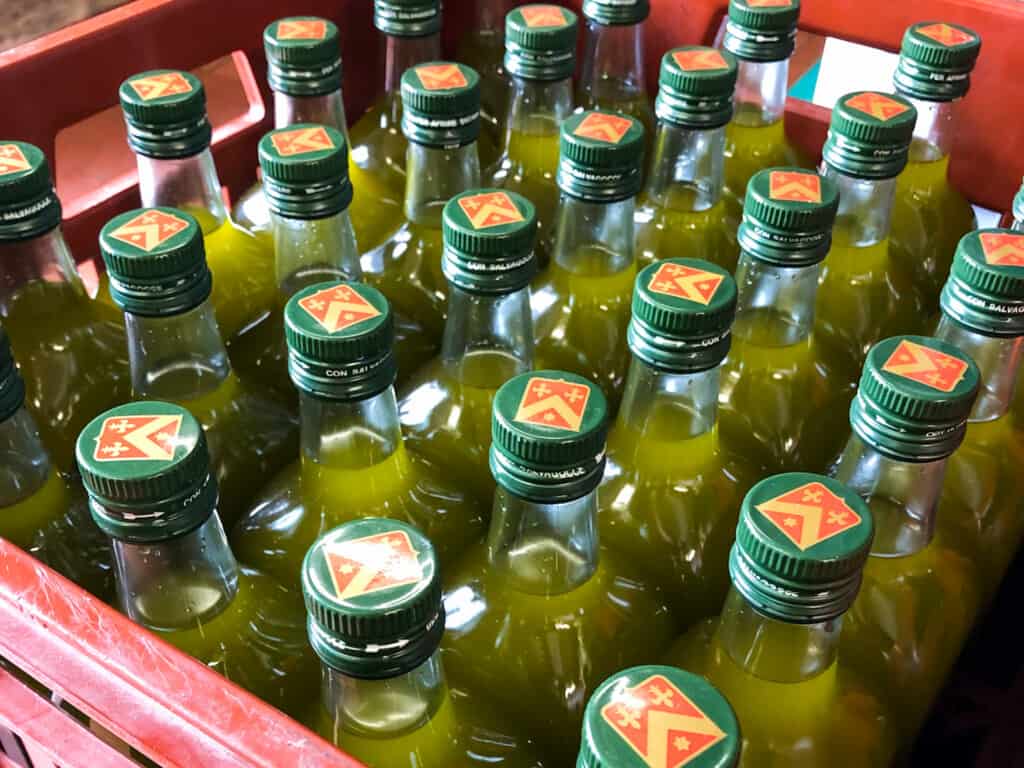
Making parmesan olive oil isn’t a very traditional Italian way of using leftover parmesan rinds but it has become quite trendy in the US. Simply place a couple of leftover parmesan rinds in a jar, cover with extra virgin olive oil and let it sit for two days. The parmesan will infuse the oil with its nutty, salty flavor.
Serve the oil on toasted bread or with vegetables for dipping (called pinzimonio in Italian).
How To Store Leftover Parmesan Rinds

The easiest way to store leftover parmesan rinds is in a ziplock bag in the freezer for up to 9 months. I find I never even get close to this time limit as I am usually making some kind of rice, stew or soup every week.
Leftover Cheese Rinds Of Any Kind
You can really use leftover rinds of any cheese as long as they aren’t full of wax. I also enjoy using pecorino romano rinds in place of parmesan. It’s a little more pungent and earthy then parmigiano-reggiano.
When choosing which cheese rinds to use, consider the age. Aged cheese rinds pack a punch of flavor while younger cheeses do not.
Learn More: Study up on other types of Italian formaggio with our Complete Guide to Italian Cheese!
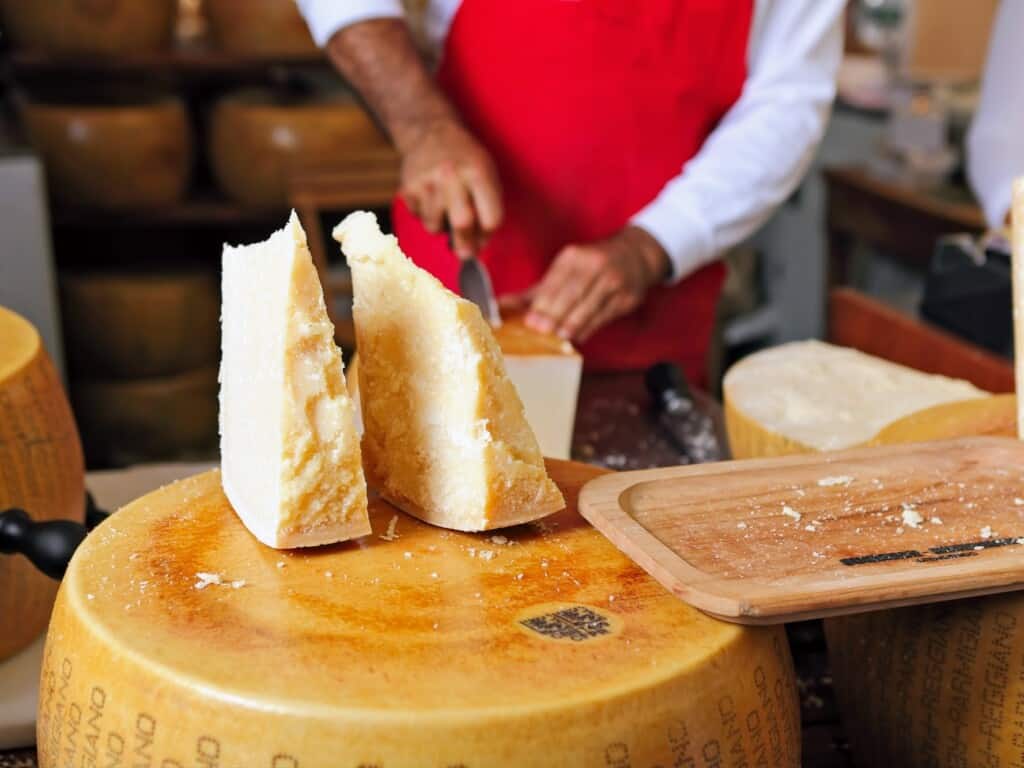
How To Use Leftover Parmesan Rinds FAQ
You can use leftover parmesan rinds in really any dish that will be cooking for at least 30 minutes. The top dishes to use parmesan rinds are soups, pasta sauces such as tomato or meat sauce, in beans, in risotto and in stocks.
If you are using real parmigiano-reggiano then yes, you absolutely can because there is no coating or wax on the rind. It’s 100% edible. If you are using imitation parmesan then be sure there is no wax in the rind.
Add a leftover parmesan rind to any soup and simmer for at least 30 minutes. The heat will slowly soften the parmesan and release its nutty, salty flavor, adding body and silkiness to your soup.
Parmesan rinds won’t melt entirely but they will get very soft and break down, releasing all their flavor.
Yes, add a leftover parmesan rind to any sauce such as tomato or bolognese, and simmer until it’s soft, about 30 minutes minimum. It will add a super nutty, earthy flavor as well as adding body and richness to your sauce.
The white specks on the parmesan rinds are actually small lactate crystals, also known as ‘cheese crystals’, which form when the cheese is aged for a long time. They are not harmful but rather, it’s a good indication of good flavor!
Adding a leftover parmesan rind adds body and silkiness to any dish but also a salty, nutty, earthy flavor. It’s also considered to have that umami flavor that is so prized within the culinary word.
A leftover parmesan rind should cook for at least 30 minutes, which allows it to release as much flavor as possible and soften fully. The longer the better though!



